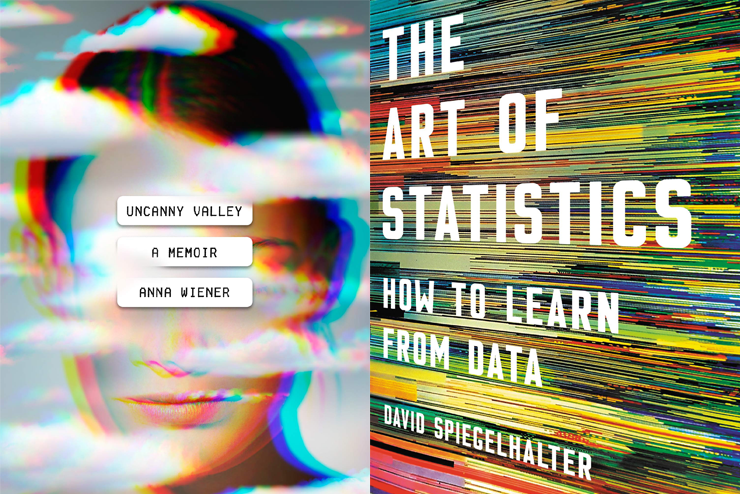The Art of Statistics, by David Spiegelhalter (Basic Books; 448 pp., $32.00). Eminent statistician David Spiegelhalter has written a primer on his expertise intended for the general reader. It’s one of those “for the rest of us books” which promises to take a complex technical subject and simplify it, sort of like Analytic Geometry for the Rest of Us, or Differential Equations Made Simple, or Imaginary Numbers For Idiots.
To his credit, he sometimes does an admirable job in educating the masses, despite possessing a formidable academic pedigree that sometimes makes the holder incapable of explaining their discipline to the unanointed. Sir David (he has been knighted by Queen Elizabeth) is chair to the Winton Centre for Risk and Evidence Communication at Cambridge University, a fellow in the Royal Society, and a recipient of bronze, silver, and gold Guy Medals from the Royal Statistical Society.
Spiegelhalter in the early chapters of his book explains, among other things, how charts and graphs can be made misleading, and how survey questions, reworded, can yield substantially different responses. One is reminded of Mark Twain’s comment, “There are three types of lies: lies, damned lies, and statistics.”
Luckily for us, Spiegelhalter tells no lies. However he does descend deeper into the weeds of factual derivations and statistical analysis as the book goes on. Other reviewers of The Art of Statistics hail it as “equation free” and “totally understandable by anyone.” This is superficially true, although if the reader seeks a deeper understanding, he is invited to consult a glossary at the end of the book which is anything but free of jargon or mathematics. Look up the “least squares” term and you will get an almost full-page description of the least squares regression line that runs to three detailed equations and four other explicative factors. The entry concludes by saying, “The gradient b1 and Pearson’s correlation coefficient r are related through the formula b1 = rsy/sx, so if the standard deviations of the xs and the ys are the same, then the gradient is exactly equal to the correlation coefficient.” Everybody comfy with that? Didn’t think so.
More entertaining are the author’s application of statistical analysis to a number of diverse events, including the records of serial killers in England and Wales, 30-day survival rates in England of patients following heart surgery, the risk of eating bacon sandwiches (I’m not kidding), and world population trends.
The gist of all this is that statisticians can have a tremendous influence on how and why we come to certain conclusions in business, finance, sports, and warfare.
Spiegelhalter has given us a good overview of this branch of mathematics, but make no mistake, it is not truly for beginners. His opening sentence in the last chapter of the book tells it best: “To put it bluntly, statistics can be difficult.”
(Christopher Timmers)
Uncanny Valley: A Memoir, by Anna Wiener (MCD; 288 pp., $27.00). This memoir about life in Silicon Valley may fall short in terms of objectivity and rigor, however, for those willing to overlook its pedantic lapses, Wiener’s text is a good introduction to the U.S. technology industry subculture.
Some of the cultural and economic peculiarities of Silicon Valley will be interesting to Chronicles readers, and Wiener examines the Valley’s problems with gentrification, labor rights, freedom of speech, and women’s place in the male-dominated techie workplace. Most interestingly, Wiener describes how she and her generational cohort think, feel, and talk, and how they react to modern day pressures.
Much of her story gibes with any smart 20-something’s journey from optimism to disillusionment, from any age or place. “None of us had anticipated that success would be to the detriment of what made the place feel special,” as she wistfully puts it. Millennial disappointment has become a rite of passage, which is no surprise after a childhood festooned with participation trophies. This aspect of Uncanny Valley may cause some to shrug. Others will recognize their own days of early optimism, and recall the discomfort they felt in joining a corporate machine.
Reminiscences aside, Wiener’s strangely elliptical style gets in the way of her narrative. Rather than naming Trump, she caricatures a then-presidential candidate as “a real estate developer who had once played the part of a successful businessman on reality television.” And the “social network everyone said they hated but no one could stop logging in to” is easily decoded as Facebook. I understand; the publisher’s legal counsel likely influenced her circumlocutions. But I found the lack of directness off-putting in its repetition.
Oddly, the rare time Wiener talks in specifics, she still obfuscates. She “humble brags” about the amount of her take from exercising stock options from a $7.5 billion deal with a “highly litigious Seattle-based conglomerate.” A two-second internet search reveals GitHub and Microsoft as the likely parties. This odd coyness, especially for a memoir, juxtaposes with the specific six-figure success she boasts of.
Despite this stylistic annoyance, and selective revelation, Wiener provides an ethnography of the U.S. technology ecosystem for those of us looking in from the outside. Stories of crazy commutes and quotidian Bay Area life, and her intellectual jousts with a billionaire friend provide an entertaining anthropological study for the majority of Americans. Wiener’s work deserves a read for those interested in an honest look at the technological mandarins who have an outsized influence on our world.
(Pete Hammack)



Leave a Reply